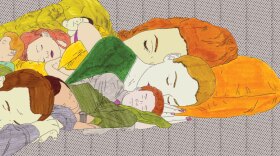Every other Friday, the Outside/In team answers a listener question about the natural world. This week’s question comes from Sydney in Natural Bridge, Va.
Why does everyone seem to have that same dream where you're falling off a cliff but you wake up just before you hit the ground?
It’s a fascinating question, according to Dr. Abhinav Singh, a sleep physician and medical director of the Indiana Sleep Center.
“Dreams have always fascinated us from time immemorial, because dreams form that fabulous shoreline between the mind and the brain where physiology meets psychology,” Singh said.
There is so much we still don’t know about dreams and sleep. But let’s start with what scientists do understand.
The physiology of dreaming
In the 1950s, scientists discovered rapid-eye movement sleep, or REM sleep. It’s the fourth phase of sleep and the most active.
“The brain is firing on all cylinders. It's not slow. It's very fast. The eyes are fast. Consumption of energy is high, the heart rate is erratic… and it is during this state [when] we dream very vividly,” Singh said.
REM sleep is also known as “paradoxical sleep” or “dream sleep.” While we also dream in other phases of sleep, we actually remember dreams during the REM phase.
But dreaming isn’t the only thing going on during REM sleep.
“Memories are being archived and put away,” said Singh.
Our brains are also working on emotional regulation during this phase. Research shows that when we’re well-rested, we’re better able to let things go when we’re awake and not get overly bothered by, say, getting cut off in traffic.
It’s not clear whether or not dreams are critical to these functions, or if they’re simply happening at the same time.
There are also stories of people struggling with a difficult problem, and coming up with the solution in a dream.
“The famous benzene ring solution that had fascinated organic chemists forever was solved in a state of dream,” Singh said.

The psychology of dreaming
Let’s turn to another lens: the psychological.
Just within Western psychology, there are many different theories about what dreams mean.
Over a century ago, Sigmund Freud published The Interpretation of Dreams, which is still read today. Freud contended that dreams contain meaningful symbols and reveal our unconscious desires.
Another theory says dreams are an opportunity for threat simulation: a rehearsal for dangerous events in waking life, like falling off a cliff.
Others say dreams are meaningless, a random assortment of images, both recalled and invented.
So, what does it mean when you fall off a cliff in a dream?
As a clinician, Singh was a bit reluctant to speculate in the “mind” realm, but he gave it a go. He said that the “trip and fall” dream represents an abrupt moment of emotion, like pain or fear.
So, maybe repetitive dreams are a type of fear management.
“Maybe it was evolution's way of trying to resolve these difficult situations, so that it doesn't bother you and you can move on with your day,” he said. “Maybe it was the natural way to protect you from mental health ailments such as depression.”
Sometimes, repetitive dreams cross into the realm of nightmares. Patients at the Indiana Sleep Clinic dealing with trauma or post-traumatic stress disorder (PTSD) can suffer from nightmares containing disturbing, recurring images.
His team sometimes treats these patients with “image rehearsal therapy,” in which they change the story of the nightmare while the patient is awake.
“We change the endings. We change the characters that are being hurt… think about it and then go to bed with it,” Singh said. “And it works.”
Dream on
While we might not be able to definitively explain the significance of a specific dream, the important thing, Singh explained, is that you are dreaming, and it’s a good thing if you do remember some dreams.
If you’re excessively dreaming and it’s bothering you, or you’re not dreaming at all, you should say something to your doctor, he added.
“That's the take-home message. Dream on,” Singh said. “Dreaming is healthy.”
Submit your question about the natural world to the Outside/In team. You can record it as a voice memo on your smartphone and send it to outsidein@nhpr.org or call the hotline, 1-844-GO-OTTER.
Outside/In is a podcast! Subscribe wherever you get yours.








